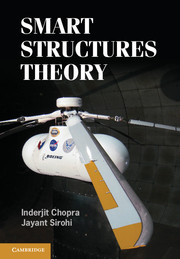Book contents
- Frontmatter
- Contents
- Preface
- 1 Historical Developments and Potential Applications: Smart Materials and Structures
- 2 Piezoelectric Actuators and Sensors
- 3 Shape Memory Alloys (SMAs)
- 4 Beam Modeling with Induced-Strain Actuation
- 5 Plate Modeling with Induced-Strain Actuation
- 6 Magnetostrictives and Electrostrictives
- 7 Electrorheological and Magnetorheological Fluids
- 8 Applications of Active Materials in Integrated Systems
- Index
- References
3 - Shape Memory Alloys (SMAs)
Published online by Cambridge University Press: 18 December 2013
- Frontmatter
- Contents
- Preface
- 1 Historical Developments and Potential Applications: Smart Materials and Structures
- 2 Piezoelectric Actuators and Sensors
- 3 Shape Memory Alloys (SMAs)
- 4 Beam Modeling with Induced-Strain Actuation
- 5 Plate Modeling with Induced-Strain Actuation
- 6 Magnetostrictives and Electrostrictives
- 7 Electrorheological and Magnetorheological Fluids
- 8 Applications of Active Materials in Integrated Systems
- Index
- References
Summary
Certain classes of metallic alloys have a special ability to “memorize” their shape at a low temperature and recover large deformations imparted at a low temperature on thermal activation. These alloys are called shape memory alloys (SMAs). The recovery of strains imparted to the material at a lower temperature, as a result of heating, is called the shape memory effect (SME). The SME was first discovered by Chang and Read in 1951 in the Au-Cd (gold-cadmium) alloy system. However, the effect became more well known after the discovery of nickel-titanium alloys.
Buehler and Wiley [1, 2] discovered a nickel-titanium alloy in 1961 called NiTiNOL (i.e., Nickel Titanium alloy developed at the Naval Ordinance Lab) that exhibited a much greater SME than previous materials. This material was a binary alloy of nickel and titanium in a ratio of 55% to 45%, respectively. A 100% recovery of strain up to a maximum of about 8% pre-strain was achieved in this alloy. Another interesting feature noticed was a more than 200% increase in Young's modulus in the high-temperature phase compared to the low-temperature phase. Subsequently, it was determined that the percentage of nickel and titanium influences the material properties of Nitinol and can be varied to control the transformation temperatures in the material [3]. Also, the addition of a third or fourth element (most commonly copper) to NiTi can be used to selectively control some properties of SMA wires.
Information
- Type
- Chapter
- Information
- Smart Structures Theory , pp. 194 - 304Publisher: Cambridge University PressPrint publication year: 2013
References
Accessibility standard: Unknown
Why this information is here
This section outlines the accessibility features of this content - including support for screen readers, full keyboard navigation and high-contrast display options. This may not be relevant for you.Accessibility Information
- 4
- Cited by
